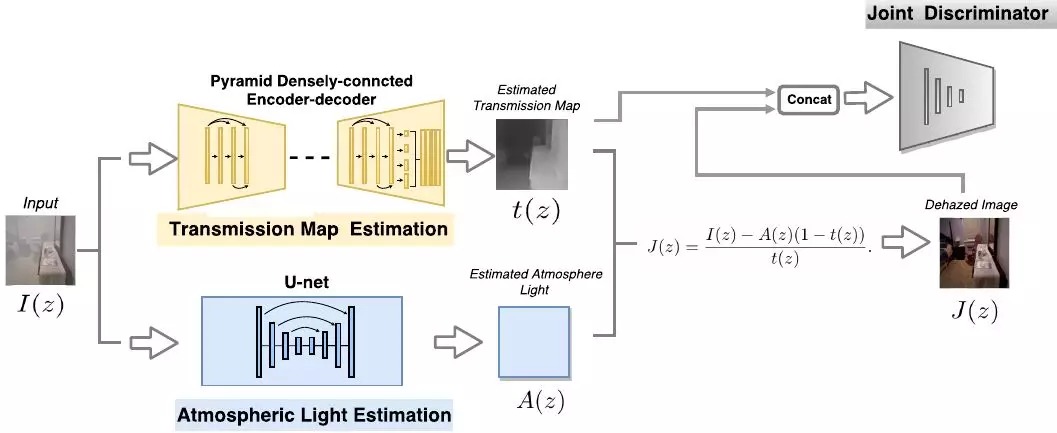Zhang H, Patel V M. Densely connected pyramid dehazing network[C]//Proceedings of the IEEE conference on computer vision and pattern recognition. 2018: 3194-3203.
1. Overview
1.1. Motivation
Most existing method
- inaccuracies in the estimation of transmission map
- not leverage end-to-end training, unable to capture the inherent relation among transmission map, atmospheric light and dehazed image
In this paper, it proposed Densely Connected Pyramid Dehazing Network (DCPDN)
- jointly learn transmission map, atmospheric light and dehazed image
- multi-level pyramid pooling for the estimation of transmission map
- edge-preserving loss function
- joint-discriminator
- stage-wise learning
1.2. Contribution
- jointly network
- jointly discriminator
- edge-preserving loss, edge-preserving pyramid densely connected encoder-decoder network
- experiments, ablation study
1.3. Related Work
1.3.1. Prior-based
1.4. Dataset
A∈[0.5, 1], β∈[0.4, 1.6]. random sample 4 groups.
- TrainA. 1000 images from NYU-depth2, get 4000 paris
- TestA. 100 images from NYU-depth2, get 400 paris
- TestB. 200 paris fromMiddlebury and Sun3D
2. Network

2.1. Pyramid Densely Connected Transmission Map Estimation Net

dense: maximize information flow.
- Encoder. 5 (dense block + down-sample transition block)
- Decoder. 5 (dense block + up-sample transition block)
- Multi-level pyramid pooling module. deal with lacking of global structure information
2.2. Atmosphere Light Estimation Net
- U-net. 4 (Conv-BN-Relu) + 4 (DeConv-BN-Relu)
2.3. Joint Discriminator

2.4. Edge-preserving Loss

- (set 1) L2 loss of transmission map
- (set 0.8) two-directional gradient loss
edge corresponds to the discontinuities in the image intensities.

- (0.8) feature edge loss
low-level features (edges and contour) can be captured in the shallow layers.

relu1-1 and relu2-1 of VGG16.
2.5. Loss Function

- L^t. edge-preserving loss
- L^a. L2 of atmospheric loss
- L^d. L2 of dehazed loss
- (0.25) L^j. joint Discriminator loss
Stage-wise training and then fine-tuned.
3. Experiments
3.1. Details
- LR. 0.002, Adam
- batch size 1, 512x512, 400000 iteration
3.2. Ablation Study

- multi-level pooling. better preserve the global structural for obj with relatively larger scale
- edge-preserving loss. better refined the edge of transmission map
- joint Discriminator. enhance the transmission map
3.3. Comparison


